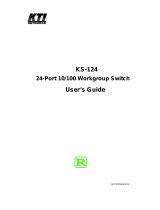
8
Chapter 3
Configuration and Application
This chapter shows you how the Switch works, and how to install the Switch and also to
congure the smart functions provided in the 16-port model.
3.1 The Switch Operation
Address Table
The Switch is implemented with an address table. This address table composed of many
entries. Each entry is used to store the address information of some node in network,
including MAC address, port no, etc. The information comes from the learning process
of Ethernet Switch.
Learning
When one packet comes in from any port. The Ethernet Switch will record the source
address, port no. and the other related information in address table. These information
will be used to decide either forwarding or ltering for future packets.
Forwarding & Filtering
When one packet comes from some port of the Ethernet Switch, it will also check the
destination address besides the source address learning. The Ethernet Switch will lookup
the address table for the destination address. If not found, this packet will be forwarded
to all the other ports except the port which this packet comes in. And these ports will
transmit this packet to the network it connected. If found, and the destination address is
located at different port from this packet comes in, the Ethernet Switch will forward this
packet to the port where this destination address is located according to the information
from address table. But, if the destination address is located at the same port with
this packet comes in, when this packet will be ltered. Thereby increasing the network
throughput and availability
Store-and-Forward
Store-and-Forward is one type of packet-forwarding techniques. A Store-and-Forward
Ethernet Switch stores the incoming frame in an internal buffer, do the complete error
checking before transmission. Therefore, no error packets occurrence, it is the best
choice when a network needs efciency and stability.
The Switch scans the destination address from the packet header, searches the routing
table provided for the incoming port and forwards the packet, only if required. The fast
forwarding makes the switch attractive for connecting servers directly to the network,
thereby increasing throughput and availability. However, the switch is most commonly
used to segment existing hubs, which nearly always improves overall performance.
A Ethernet Switch can be easily congured in any Ethernet network environment to
signicantly boost bandwidth using conventional cabling and adapters.
Due to the learning function of the Ethernet switch, the source address and corresponding
port number of each incoming and outgoing packet are stored in a routing table. This
information is subsequently used to lter packets whose destination address is on the
same segment as the source address. This connes network trafc to its respective




















